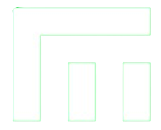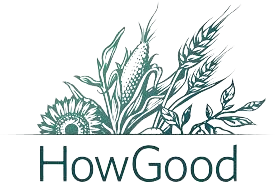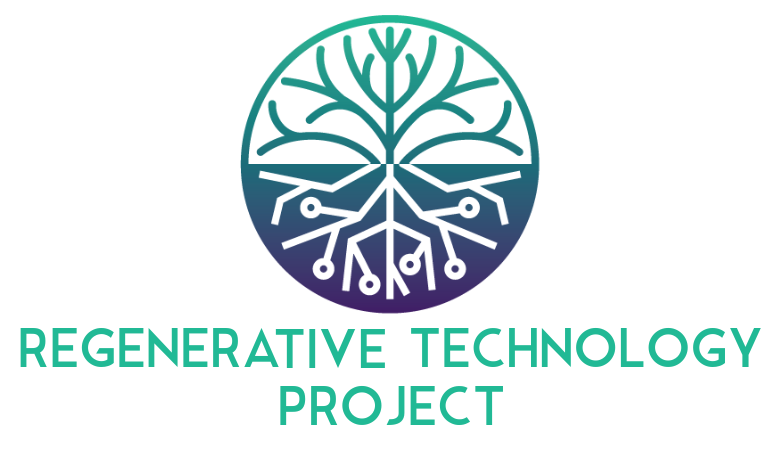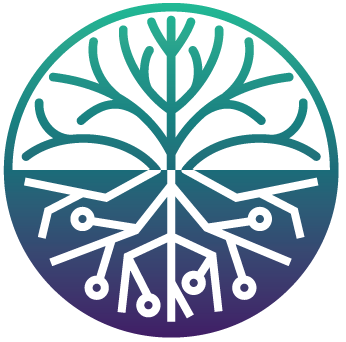Showcase
The field of Regenerative Tech is emerging, with new examples launching daily. This selection is a snapshot of examples across various industries. They represent leaders, designers, builders, practitioners, investors, and all of us.
Because we all have a stake.

Materiom’s platform helps accelerate R&D for product materials that are good for the planet
Materiom’s platform helps accelerate R&D for product materials that are good for the planet.
- Materiom’s AI-powered optimization engine develops recipes across biopolymers, product niches, and regions. Sourcing analytics are designed to prevent over-extraction.
- Provides open data commons for material recipes made from abundant sources of natural biomass.
- Materiom community brings together a range of materials innovators across supply chains.
REGENTECH DESIGN BENEFITS
| enables BIOPHILIC DESIGN |
Biopolymer data OPEN SOURCED |
helps LOCALIZE |
supports ECOSYSTEM REMEDIATION |
Regenerative potential
- Accelerates shift from petro- to bio-based products, affects every industry.
- Supports quantifiable forecasting for regenerative ag/aquaculture investment
- Fosters cross-pollination across industries, critical for circular business models
Notable risks
- Limits of digitization, lab vs. real-world
- How to preserve focus on risk of over-extraction vs. commercialization pressures
- How to maintain .org (ownership/finance structure that prioritizes planetary health)

Ecosia’s search engine plants trees with every search, funding reforestation, not advertising
- Ecosia’s search platform generates millions in profits every month and, as of the Q1 2024, has used these yields to plant over 200M trees around the world.
- With each query, users remove 1kg of CO2; via estimation that tree absorbs 50kg of CO2 over 15 year lifespan.
- Does not sell data to 3rd party advertisers; powered by Microsoft Bing.
- Powers data center through renewable energy (proprietary solar plant).
REGENTECH DESIGN BENEFITS
| supports ECOSYSTEM REMEDIATION |
creates NETWORK EFFECTS |
enables MEASURING & MONITORING |
helps INSPIRE |
Regenerative potential
- Demonstrates regenerative potential of high volume digital business models, empowering people and companies to participate regeneratively
- Works with local communities and organizations to target tree planting
- Targets biodiversity risk zones, planting over 500 different native species where they are needed across 35+ countries
Notable risks
- All algorithmic search presents risks around confirmation bias; greenwashing concerns
- Reliance on Microsoft’s Bing, for-profit search leaves Ecosia vulnerable to changing terms of technical flaws
- Limited features compared to larger search giants

Oneka’s autonomous desalination system uses the power of waves for drought-proof water supply
- Oneka’s wave-powered desalination technology is designed to make oceans a sustainable source of freshwater.
- Supports “Water-as-a-Service” model, supplying solution without high capital costs (reducing financial, construction, insurance, operation and maintenance risks).
- Modular design allows economic scale-up/down; supporting remote and urban communities, industry, emergency relief, tourism.
REGENTECH DESIGN BENEFITS
| supports RENEWABLES |
supports ECOSYSTEM REMEDIATION |
helps LOCALIZE |
enables ACCESS & PARTICIPATION |
Regenerative potential
- Accelerates shift to renewables and localized water sovereignty.
- “Net Positive” operations require no electricity, land-based real estate, generate no greenhouse gases, plastics, chemicals.
- Protects marine biodiversity with ecofriendly brine, intake process, anchors encourage life.
- Supports and trains local technicians for maintenance and repairs.
Notable risks
- Unseen disruption to coastal/marine life (noise, visual impacts)
- Community acceptance, impacts on livelihoods, cultural traditions
- Reliability, maintenance, durability

Fairbnb’s sharing economy platform reinvests value within the communities it serves
- Fairbnb’s short-term rentals marketplace platform is like AirBNB, but reinvests 50% of all platform fees back into local social and environmental or community projects or NPOs
- Digital platform enables search, booking, host verification, and liability oversight; hosts social network for community stakeholders and change-makers
- FairBNB offers open data access, working with governments to promote local/regional regulations encouraging sustainable tourism
REGENTECH DESIGN BENEFITS
| fosters COMMUNITY |
facilitates COORDINATION & CONSENSUS |
helps LOCALIZE |
travel data OPEN SOURCED |
Regenerative potential
- Invests/re-circulates platform fees generated from rentals back into community to benefit local projects and nonprofits
- Cooperative model shares ownership across local hosts, business owners, guests; governed by “local nodes”
- Localized governance enables neighborhoods to decide how platform and fees are stewarded in their communities
Notable risks
- Digital platform has limited reach in remote communities without internet access
- Open data models carry security and privacy dynamics, which require mitigation
- Limitations of scale while balancing community, competing with more profitable giants

Empower.eco transforms plastic waste into economic value
- Empower’s platform enables recording and rewarding of plastic credits across the entire plastics value chain, operating across 40+ countries
- Uses mobile, blockchain, and tokenized plastic credits to enable traceability, certified product passports, and incentivize people to contribute
- By easily tracking plastic from clean-up to processing, manufacturers and brands can more easily comply with regulations and certification requirements
REGENTECH DESIGN BENEFITS
| enables CIRCULARITY |
affixes VALUE TO THE UNDERVALUED |
enables ACCESS & PARTICIPATION |
supports ECOSYSTEM REMEDIATION |
Regenerative potential
- Supports local participation in ocean and land restoration, while ensuring financial benefits are shared equitably
- Fosters collaboration and incentive alignment across plastics value chain, critical for circularity to scale
- Converts ecological damage and liability into economic value
Notable risks
- Limits of digitization, lab vs. real-world
- How to preserve focus on risk of over-extraction vs. commercialization pressures
- How to maintain .org (ownership/finance structure that prioritizes planetary health)

Regen Network’s digital infrastructure helps enable suppliers and buyers to incentivize ecological regeneration
- Regen Network provides infrastructure to create digital assets called ecocredits: verified ecological benefits such as carbon sequestration, biodiversity restoration, or water quality improvement.
- Anchors ecological data on the Regen Ledger blockchain, ensuring transparency, issuance, transfer, and retirement of credits.
- Modular platform, customizable to meet specific bioregional or credit issuing needs, offers toolkits and training programs for local adoption.
REGENTECH DESIGN BENEFITS
| supports ECOSYSTEM REMEDIATION |
affixes VALUE TO THE UNDERVALUED |
helps LOCALIZE |
facilitates COORDINATION & CONSENSUS |
Regenerative potential
- Supports localization, both of ecocredit generation and ensuring financial benefits of ecological regeneration are shared equitably
- Coordinates local communities, land stewards, organizations, scientists, and credit buyers to work together to incentivize ecosystem regeneration, realigning economics of agriculture.
- Promotes community governance of blockchain protocol to mitigate risks of power asymmetries in ecocredits marketplace
Notable risks
- Digital platform has limited reach in remote communities without internet access.
- Carbon market and blockchain market reputations create skepticism, learning curve, access barriers.
- Limitations of scale and “fungibility,” while balancing community and local requirements.

Ecovative’s AirMycelium technology is optimizing and democratizing “mycotecture” across industries at scale
- Ecovative’s AirMycelium platform grows more than 400 tons of furniture, goods, and packaging annually with clients in CPG, housing, packaging, fashion, food, beauty, sports, plastics…
- AirMycelium biomaterials platform optimizes mushroom mycelium for scale, density, elasticity, and other industrial parameters
- Ecovative generates revenue through multiple streams, leveraging its mycelium-based technology across various sectors. They license their technology to other companies, form strategic partnerships for large-scale production, R&D, and sell products directly to consumers and businesses. They also generate revenue by enabling producers around the world with 31 countries using its “Grow It Yourself “GIY” kits.
- Ecovative’s business model enables producers around the world with 31 countries using its “Grow It Yourself “GIY” kits.
REGENTECH DESIGN BENEFITS
| enables BIOPHILIC DESIGN |
enables CIRCULARITY |
helps LOCALIZE |
supports ECOSYSTEM REMEDIATION |
Regenerative potential
- Accelerates shift from petro- to bio-based products, affects every industry.
- Illustrates potential of biological engineering by using naturally occurring fungi recipes to develop materials superior in performance fire and water resistance, durability, and efficiency.
- Platform business model helps “democratize” mycotecture and enable small-scale manufacturers to localize recipe development.
Notable risks
- Bioengineering and synthetic biology introduce novel risks and uncertainties.
- Democratization carries risks of nefarious, irresponsible, unregulated use.
- Scaling up production to meet widespread demand could pose challenges, as cultivation requires specific conditions.

HowGood’s software platform uses big data to support food suppliers with more holistic metrics and regenerative benchmarking.
- HowGood’s SaaS platform enables analysis of environmental + social impacts of products, from over 33,000 materials and ingredients, >600 vetted data sources across 90,000 emissions factors.
- Developed data-driven method for tracking holistic metrics, far beyond crop yield.
- These metrics help support and benchmark brands around decision-making, goal tracking, accountability, marketing, product and supply chain innovation.
REGENTECH DESIGN BENEFITS
| supports MEASUREMENT & MONITORING |
affixes VALUE TO UNDERVALUED |
creates NETWORK EFFECTS |
supports ECOSYSTEM REMEDIATION |
Regenerative potential
- Agreeing on a common set of metrics supporting “regenerative agriculture is critical for food system transformation
- Enabling visibility and benchmarking around these metrics can create competitive pressures to optimize for them
- Supports investment, policies, and empirical foundations for regenerative agriculture
Notable risks
- Limitations of data to capture, monitor, and algorithmically compare complexities and local nuances within agricultural systems
- Risks of greenwashing concerns if companies exploit marketing ratings, obfuscating other shortcomings
- Current focus on large food businesses risks overlooking smaller farm and suppliers

Giveth is a community-driven donation platform for public goods and regenerative funding opportunities
- Giveth’s platform facilitates cryptocurrency donations to projects across a range of
- Donations are recorded on its blockchain, which verifies positive impact; Participants receive GIV coin for donations, and can use GIV to participate in voting and platform decision-making and governance
- ~$2M donated; 5,900 givers have supported 2,600+ projects; Projects keep 100% of funds raised
REGENTECH DESIGN BENEFITS
| facilitates COORDINATION & CONSENSUS |
affixes VALUE TO UNDERVALUED |
supports OPEN SOURCE |
enables ACCESS & PARTICIPATION |
Regenerative potential
- Allows anyone to open (crypto) funding portals by creating projects for their impact initiatives, fostering a collaborative ecosystem for positive social and environmental impact.
- Makes charitable giving more transparent, efficient, and democratic. Bottom-up capital model can help shift reliance from top-down technocratic philanthropic model
- Creates compounding incentives (digital assets) for giving
Notable risks
- Accessibility and adoption barriers associated with cryptocurrencies, wallets, Web3 UX
- Volatility, reputation, regulatory challenges associated with cryptocurrencies could hinder impact potential
- Limitations of blockchain-based verification for real-world impact; energy trade-offs of running such a system at scale
The Internet
Imagine the Internet as a regenerative technology
- What began as a decentralized network of information circulation; a commons…
- Has been heavily co-opted, fragmented, and financialized by governments, corporations, and Big Tech companies
- The Internet remains a complex system, capable of adaptation. If we applied living systems principles the Internet, how might it change?
REGENTECH DESIGN BENEFITS
| supports ECOSYSTEM REMEDIATION |
affixes VALUE TO UNDERVALUED |
helps LOCALIZE |
facilitates COORDINATION & CONSENSUS |
Regenerative potential
- Information complexity and circulation are foundational to life; the Internet represents a new potential substrate for humanity’s collective evolution
- Global infrastructure supports localization, decentralized coordination structures, novel economic assets and incentive models, network effects, and greater collaboration
- Open Source represents robust digital commons precedent and resource
Notable risks
- Massive and entrenched information (power) asymmetries of centralized ownership and control
- Global internet infrastructure demands significant and growing energy resources
- Nationalistic geopolitical strategies increasingly oriented around techno-economic supremacy






